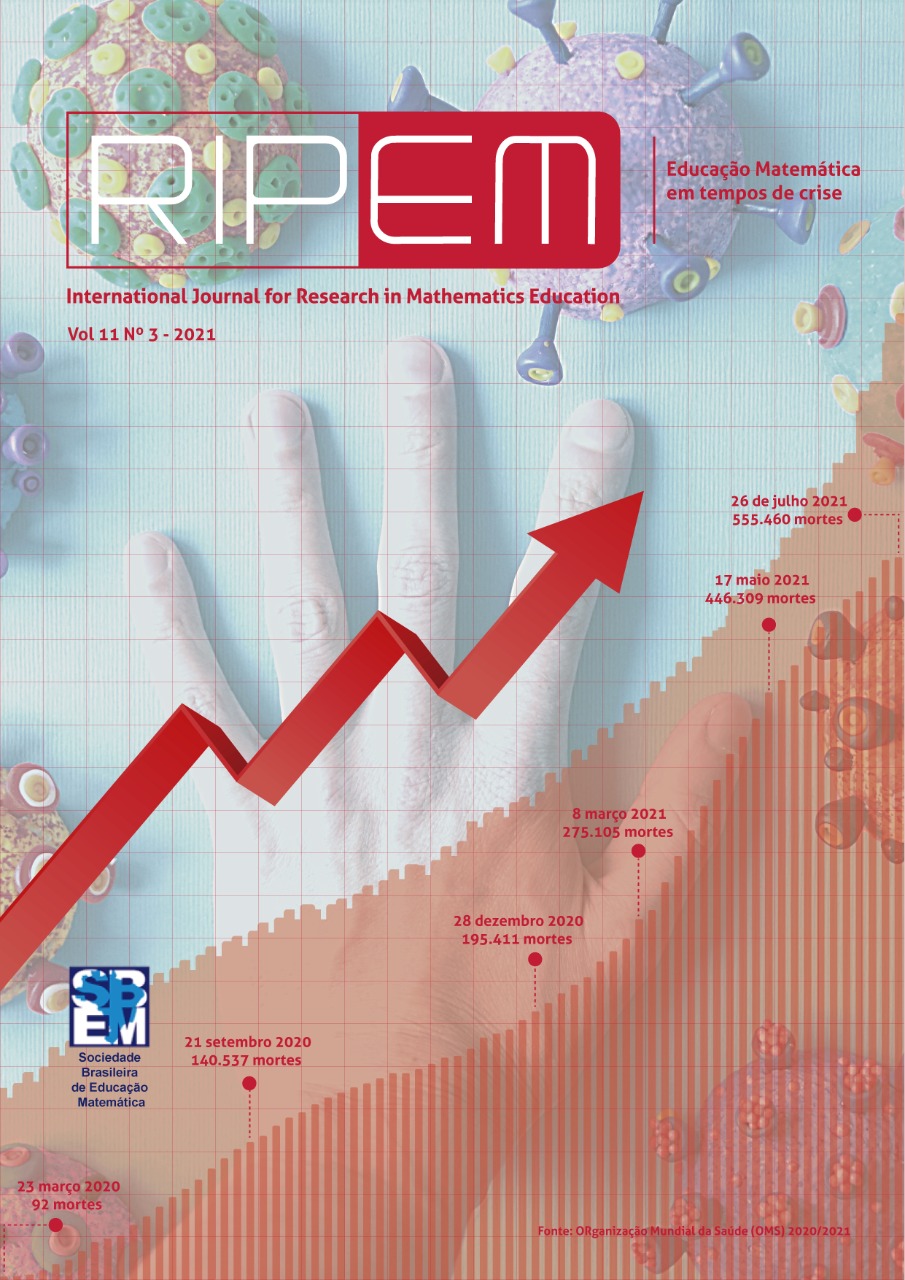The pandemic from another perspective: an experience with photographs in the non-classroom teaching of Spatial Geometry
DOI:
https://doi.org/10.37001/ripem.v11i3.2459Keywords:
Perspective, Spatial Geometry, Photography, Digital Mathematical PerformanceAbstract
In view of the need to develop strategies for non-face-to-face education due to the new coronavirus pandemic, in this article we share an experience of teaching perspective from the use of photographs. The task sought to subsidize the study of spatial geometry, using one of the types of perspective to produce photos with themes associated with the pandemic. It was held in the second half of May 2020, with 116 students from three classes of the second year of Integrated High School of a federal professional education institution. In this article, our aim was to discuss how knowledge about perspective contributed to the production of digital mathematical performances on the pandemic. For this, we conducted a theoretical discussion about the teaching of geometry and digital mathematical performances, followed by a description of the work performed, reflections emerging from the process and general considerations about the activity. At the end, we associate the photographs with socio-critical themes, reflecting on how the knowledge of forced perspective influenced the students' photographic performances. Without romanticizing the complex historical moment experienced, we believe that we conducted a practice of Mathematical Education that sought to reinforce preventive measures, enhance the performance of workers in essential services and pay attention to students and families about the social impact resulting from the pandemic. Thus, we conclude that the photographic act established a guiding thread for the aspects of geometric visualization and its representation, enhancing the teaching of geometry.
Downloads
References
Borba, M.; Scucuglia, R.; Gadanidis, G. (2014). Fases das tecnologias digitais em Educação Matemática: sala de aula e Internet em movimento. Belo Horizonte: Editora Autêntica.
Borba, M. C., & Villarreal, M. E (2005). Humans-With-Media and the reorganization of Mathematical Thinking: information and communication technologies, modeling, experimentation and visualization. New York: Springer.
Brasil. Ministério da Saúde (2020). Sobre a doença. Retirado em 24 de agosto de 2020, de https://coronavirus.saude.gov.br/sobre-a-doenca#como-se-proteger
Carvalho, M. L. O. (2010). Representações planas de corpos geométricos tridimensionais: uma proposta de ensino voltada para a codificação e decodificação de desenhos. Dissertação (mestrado) – Universidade Federal de Ouro Preto, Mestrado Profissional em Educação Matemática, Ouro Preto, MG.
Dutra, N. C. G. (2020). A experiência da rede pública estadual do Maranhão no contexto da Covid-19: os desafios das desigualdades sociais e as novas tecnologias na educação no século XXI. Revista Pedagogia Cotidiano Ressignificado, 1(4), pp. 111-119.
Eves, H. (1994). Tópicos de história da matemática para uso em sala de aula: geometria. Atual, São Paulo.
Freire, P. (2002). Pedagogia da autonomia. São Paulo: Paz e Terra.
G1. Governo adota reabertura gradual e alternada do comércio. Retirado em 28 de agosto de 2020, de https://g1.globo.com/es/espirito-santo/noticia/2020/05/08/governo-do-es-adota-reabertura-gradual-e-alternada-do-comercio-entenda.ghtml
Gutiérrez, A. (1996). Visualization in 3-dimensional geometry: in search of a framework. 145 In: L. Puig, A. Gutiérrez (Eds.). Proceedings of 20th PME Conference, v. 3, p. 19-26, Universidade de Valência, Espanha, 1996.
Lima, L. C. & Moisés, R. P. (1998). A Forma: movimento e número: proposta didática para a aprendizagem da linguagem geométrica. São Paulo: Programa Integrar - CUT, SP.
Lima, L. C.; Moisés, R. P. (2002). Uma Leitura do Mundo: forma e movimento. São Paulo: Escolas Associadas.
Moreira, H. & Caleffe, L. G. (2008). Metodologia da pesquisa para o professor pesquisador. 2. ed. Rio de Janeiro: Lamparina.
Nacarato, A. M. & Santos, C. A. (2014). Aprendizagem em Geometria na educação básica: a fotografia e a escrita na sala de aula. 1. ed. Belo Horizonte: Autêntica.
Neiva-Silva, L. & Koller, S. H. (2002). O uso da fotografia na pesquisa em Psicologia. Estudos de Psicologia, 7(2), pp. 237-250.
ONU Brasil (2020). Chefe da ONU pede maior proteção para crianças atingidas pela crise da COVID-19. Retirado em 28 de agosto de 2020, de https://nacoesunidas.org/chefe-da-onu-pede-maior-protecao-para-criancas-atingidas-pela-crise-da-covid-19
Rodrigues, V. L. G. C. (2006). Aprendizagem do conceito de volume e o desenvolvimento intelectual: uma experiência no ensino fundamental. Dissertação (mestrado) – Universidade Estadual de Maringá, Programa de Pós-graduação em Educação, Maringá, PR.
Rovetta, O. M. (2015). Interações em sala de aula e em redes sociais no estudo de sólidos geométricos no ensino médio. Dissertação (mestrado) – Instituto Federal do EspÃrito Santo, Programa de Pós-graduação em Educação em Ciências e Matemática, Vitória, ES.
Rovetta, O. M., & Silva, S. A. F. (2020). Reflexões sobre uma trajetória de ações envolvendo perspectiva e fotografia. Educação Matemática em Revista-RS, 2, pp. 27-36.
Saraiva, K., Traversini, C., & Lockmann, K. (2020). A educação em tempos de COVID-19: ensino remoto e exaustão docente. Práxis Educativa, 15, pp. 1-24.
Segadas, C. (Org.). (2008). Visualizando Figuras Espaciais. Rio de Janeiro: IM/UFRJ.
Trojack, C. L., & Wrobel, J. S. (2017). Performance Matemática Digital. In: C. L. Trojack, J. S. Wrobel &, V. Oechsler (Orgs.). Matemática com arte: sugestões de atividades interdisciplinares (pp. 107-115). Curitiba: Appris.
Vital, C., & Scucuglia, R. R. da (2020). A criação de GIFs com o GeoGebra para produção de narrativas matemáticas digitais. Amazônia, 16(36), pp. 128-141.
Published
How to Cite
Issue
Section

This work is licensed under a Creative Commons Attribution-NonCommercial-NoDerivatives 4.0 International License.








